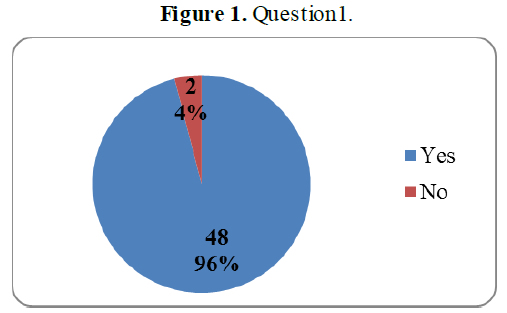
Alessio Zanier Visintin*
Abstract:
This paper aims at highlighting the outcome of a survey carried out on students of the English Language Major, at the University of Quintana Roo at Chetumal- Mexico, in the spring of 2010. The survey hinged on the usefulness of translation in the teaching of English at university level in Mexico, and consisted of seven open questions proposed to fifty students of the 8th and 10th semesters of the major. Students were required to express their opinions in full about the possible positive influence of translation as a useful tool in their foreign language learning process, on the basis of their experiences as translation students. It is important to underline that the aforementioned major does not lead to professional qualifications as translators, since it is focused on forming English teachers: nevertheless there are three optional translation subjects included in the curriculum. After a brief introduction dealing with some scholarly opinions about translation as a pedagogical tool, the survey is described, and its results are made visible through 16 pie and bar graphs, showing that students overwhelmingly considered translation as a useful pedagogical instrument in their foreign language studies, particularly as far as vocabulary acquisition and writing skills development were concerned.
Key words: translation, language learning, language skills development, language teaching methodology, multilingual approach.
Resumen: este trabajo tiene como objetivo destacar los resultados de una encuesta llevada a cabo en la carrera de Lengua Inglesa de la Universidad de Quintana Roo en Chetumal, México, en el periodo de primavera del 2010. La encuesta indaga sobre el uso de la traducción en la enseñanza del inglés a nivel universitario, en el contexto de México, y consta de siete preguntas abiertas dirigidas a 50 estudiantes de octavo y décimo semestre de la carrera. Los estudiantes expresaron sus opiniones detalladamente acerca de la influencia positiva de la traducción como herramienta de aprendizaje de una lengua extranjera, a partir de sus experiencias como estudiantes de traducción. Es importante resaltar que la carrera mencionada no conduce a cualificaciones profesionales como traductores, ya que está enfocada en la formación de maestros de inglés: no obstante, existen tres materias opcionales de traducción incluidas en el currículo. Después de una breve introducción sobre diferentes opiniones académicas selectas sobre la traducción como herramienta pedagógica, la encuesta es descrita y sus resultados se aprecian por medio de 16 gráficas, demostrando que los estudiantes consideraron abrumadoramente la traducción como un instrumento pedagógico útil en sus estudios del idioma extranjero, particularmente en la adquisición de vocabulario y en el desarrollo de habilidades de escritura.
Palabras clave: traducción, aprendizaje de idiomas, desarrollo de habilidades, metodología de la enseñanza de idiomas, enfoque multilingüístico.
Introduction
One of the most controversial issues in teaching foreign languages is still the use of translation in class. Different scholars argued that translation causes interference when teaching a foreign language, such as Howatt (1984), among others. On the other hand, many other researchers argue that translation can be used as a practical tool in order to achieve different objectives in class, for example, Harmer (1990), Edge (1993), Finocchiaro & Brumfit (1983), just to mention some of them.
Previous studies mainly focused on translation for vocabulary learning, but in this work the authors will make use of the perceptions of students who have joined to translation classes in the English Language major of the University of Quintana Roo to analyze other beneficial aspects that the implementation of translation could bring, in addition to vocabulary learning.
Cunningham (2000), in her work “Translation in the Classroom. A useful Tool for Second Language Acquisition”, highlights the use of translation as a mechanism not only to present new language, but also to reinforce previous language notions. Contrastive Analysis, implied in translation, is considered beneficial for students because they can understand the meaning of sentences even when they do not have a broad vocabulary register. Besides, they are able to deeply understand the grammar rules of the target and source languages by comparing the structure of both sentences in a meaningful context. Along the same line of thought, Durieux (2005) underlined the importance of the contrastive function of translation in foreign language teaching, especially regarding syntax and lexical structures.
Another recent work that focused on translation and language teaching was carried out by Angeles Carreres (2006), who holds that the new tendency to give a better place to translation is resulting in new textbooks with renovated ideas, such as those expressed by González Davies, (2004), Lunn and Lundsford, (2003), and Harvey, Higgins and Haywood (1994). Guy Cook (en Kavaliauskien, 2002) underlined that “Real-world foreign language use is full of translation…and for the majority of the world’s population, switching and negotiating between languages is part and parcel of everyday use”. Nunan and Lamb (1996) reinforced this stance when declaring that “Problems arise when teachers try to avoid using the first language in class…the explanation is clumsy, consumes valuable time and, judging by the students’ attempts to use it, not understood. A quick translation would have short-circuited the rather tortuous process”. Cook again (2001) claimed that “Learners need a bilingual environment with a lot of translation and a lot of code-switching and focus on form, meaning and language use”, following the same line of thought as Ross (en Kavaliauskien, 2000), who clearly stated that “Translation is useful in the EFL classroom in order to compare grammar, vocabulary, word order and other language points in English and the students’ mother tongue”. There are many other scholars in different countries, especially in the European Union, supporting these stances, implying that foreign language pedagogy is adopting translation as an effective teaching tool, and thereby reversing the myth of an English-only teaching methodology (Yule, 1996; Linder, en Kavaliauskien, 2002; Bowen and Marks, 1994; Bassnett, 1998; Paradowsky, 2007).
The act of translating words is natural in language learners, particularly at a beginner’s level, but it is persistent through the highest levels as well, so why should teachers avoid using it in their classes? In order to show sufficient evidence that this skill is a useful pedagogical tool, more theoretical support needs to be found. Hopefully, the present work could be added to those ones that corroborate the positive influence translation may have in language learning and teaching.
The purpose of this paper is to identify research outcomes and evidence of the usefulness of translation in the teaching of English as a foreign language at the Universidad de Quintana Roo, Chetumal Campus. The research topic is based on the question whether or not translation should be considered as an effective strategy in order to teach a foreign language.
Design of the Research
Participants
We worked with surveys in order to reach the general opinions of the students in the English Language Major who took translation as a subject in their curriculum. For the purpose of getting reliable and balanced results, we selected fifty students who were attending classes with three different teachers of translation subject at the University of Quintana Roo.
At the moment of the survey, the students were in their second and fourth semesters of translation (eight/tenth semester). The average age of the students is early twenties. The students’ average English level is upper- intermediate, according to the requirements of the major. The surveys were applied in their classrooms during class time.
Materials and instruments
For this research, we developed a survey consisting of seven questions that were designed to obtain the necessary information. The survey consisted of seven open questions which, besides demanding a yes/no answer, also asked students to explain the reasons for their answers.
Analysis of the results procedure
At this stage of the research we collected all the questionnaires to carefully analyze them. The seven different questions were analyzed in a separated way. First, all the answers to the question number one were read, and then we put together all the questionnaires that contained the same answers (yes/no). After this separation of questionnaires those ones which contained common opinions were selected.
For doing this selection, we read each answer more than once in order to extract key words and terms that the students tended to express recurrently in their papers. It means that we tried to find the main tendencies in their opinions. After this careful analysis, we designed two graphics for the question. The first graphic shows the number of yes/no answers. The second graphic shows the tendency of the student’s opinions. In this graphic, we tried to use concise statements to express the ideas of the students. This process was used for every question. With the benefit of hindsight, the order in which the questions were presented might not have been the most appropriate, and this factor will surely be taken into account in future research activities.
Results
Question 1:
Do you feel that your English has improved after taking translation classes?
First and foremost we have to mention that this was a yes/no question type. Students were not doubtful; they were all sure and positive about their answers. The next graphic shows the percentages of the two results arising from this question.

The graphic shows that most of the students (96%) think that translation has helped them to improve their English. Only two students (4%) think that translation is not useful in the English class.
In the next section of the analysis for this question, we are going to display the most common answers of those students who wrote an affirmative answer. The following graphic shows the most common ideas taken from different affirmative answers to question one. They expressed common aspects of their English classes they consider are being reinforced with translation.
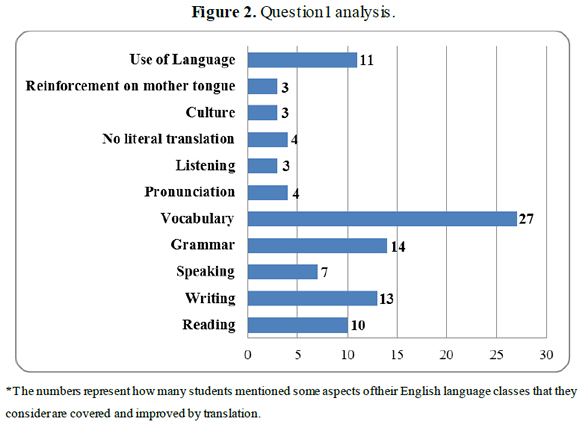
The last graphic shows a general tendency of the students about the relation between translation and vocabulary in English language learning. More than fifty percent of the students think that translation is a useful tool to acquire new vocabulary. There is also a recurrent tendency in the students’ opinion about their improvement in grammar, writing and reading skills and use of language in their English language class. To a lesser extent, they consider translation helps them to improve the speaking and listening skills. Furthermore, we could also notice that there were other concerns that the students mentioned when answering the survey. For instance, some of them agreed on acquiring more culture knowledge, reinforcing their mother tongue and improving their pronunciation through the use of translation.
On the other hand, the two students who do not think that translation is useful in their English learning, explained that they do not like the contact with their mother tongue when learning a second language. They just prefer to avoid their mother tongue because they consider that it is better to learn just by using the target language.
Question 2:
What you think about having a translation-based foreign language class?
There were three different answers for question number two: the ones whereby the students were supportive of the idea, those revealing that they did not like the proposal and those which showed uncertainties on what to decide. The answers will be displayed in a graphic in order to make them more understandable.
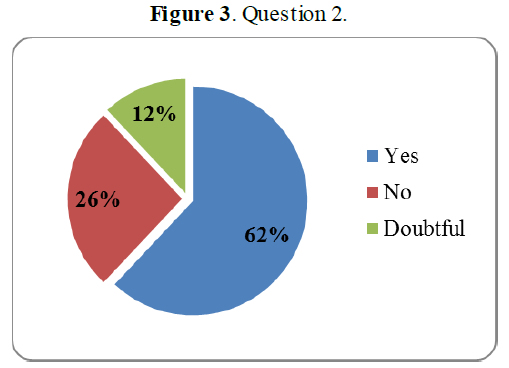
First, we are going to present the opinions of the students who think that it could be a good idea to have a foreign language class based on translation.
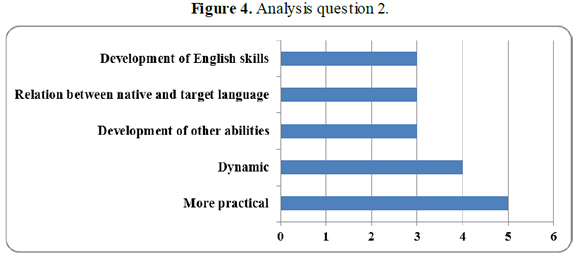
Some of the students who gave an affirmative answer to this question think that an English class by means of translation could be more dynamic and practical and other ones said that it would be a good tool in order to create a relation between native and target languages, to develop other language abilities and to develop their English skills.
Those students who are doubtful about learning English through translation think that it is necessary to have a considerable command of English before facing translation as a pedagogical tool and other ones think that it would be successful just for those students who feel comfortable with translation (Figure 5).
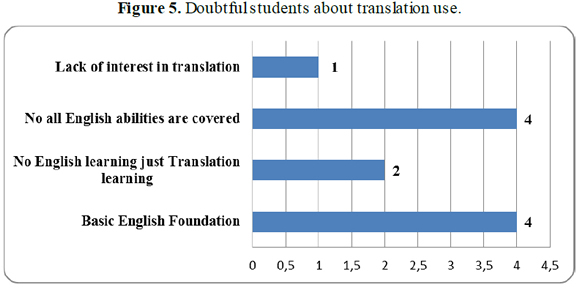
The students who had a negative answer had four common ideas. There were two answers with the same number of incidence; the first one is that not all the English abilities will be covered in a class based on translation in order to learn a foreign language, and the other one is that here is the necessity of having a solid, command of English to take a class of this nature. Two students agreed that there will be no English language learning, since they will be just developing their translation skills. Finally, one student stated that he/she is not interested in translation and thinks that it will not work.
Question 3
Is there a relation between translation and language teaching?
There were just yes and no answers for this question. The next graphic represents the incidence of the answers:
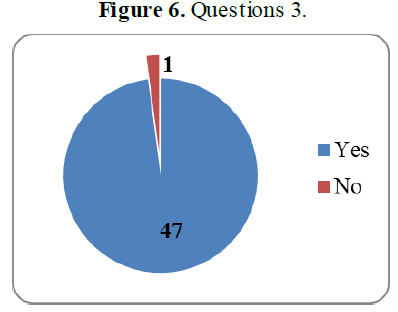
Almost all the students related translation and teaching, with the exception of just one student. The next graphic shows in which aspects they relate translation and teaching:
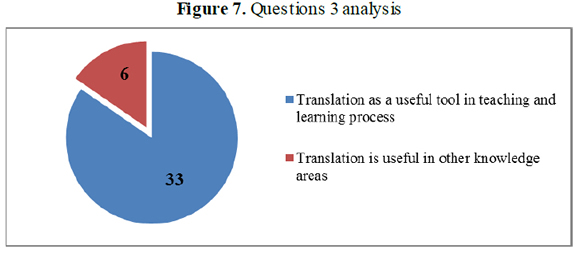
The students who stated that there was some kind of relationship between translation and teaching, agreed on two main answers. The most popular is that they consider translation is a useful tool when learning or teaching English, and the other, is that translation is useful in other areas. Students think that grammar, vocabulary acquisition and English language abilities, could be learned in a more practical way when the teacher uses translation in class. Also, they consider that translation is an excellent tool in order to improve the student progress in other knowledge areas such as culture, characteristics of the target language and reading comprehension of specific information.
Question 4
Do you consider translation as a pedagogical tool?
First, we are going to present the numbers of incidence of the yes/no answers. The next graphic represents the results:
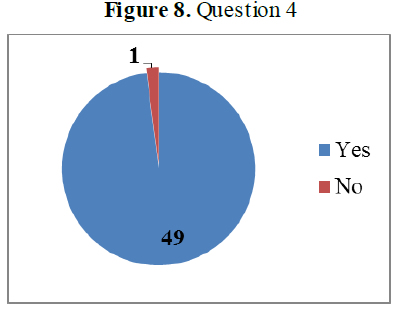
There is a clear tendency in the results; almost all students consider that translation is a useful pedagogical tool. One student disagreed because he/she thinks that translation is a bad alternative when learning or teaching a foreign language.
In the next graphic we present the most common opinions of those students who gave an affirmative answer:
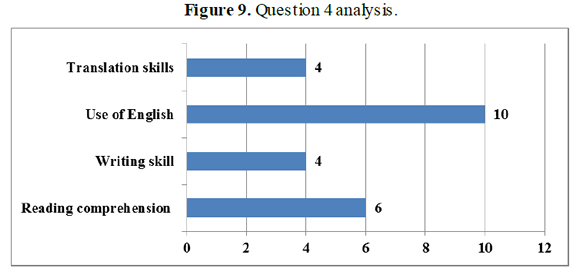
We can see that ten students think that translation works as a pedagogical tool in order to teach the correct use of English. On the other hand, some students agree on the fact that translation helps to make a progress in translation, reading and writing skills.
Question 5:
As a student, do you think that translation could be effective enough as a tool to teach a foreign language?
In this question, we found three different answers (yes, no and maybe). The next graphic presents the numbers of the incidence of answers:
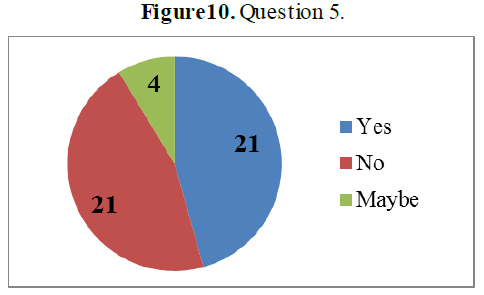
In this question, there was an equal balance of affirmative and negative answers and four students had not a definitive answer.
For this question, we present two different graphics because of the balance of the results. The first one represents the affirmative answers and the second one the negative answers. As in the last graphics we show the most common opinions:
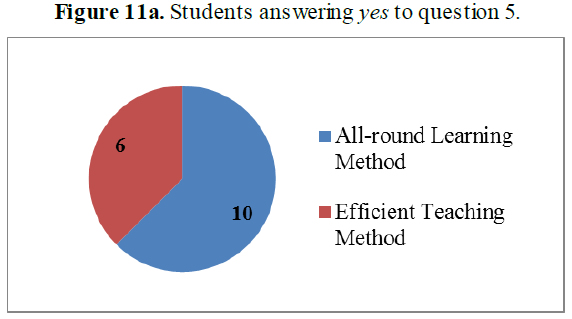
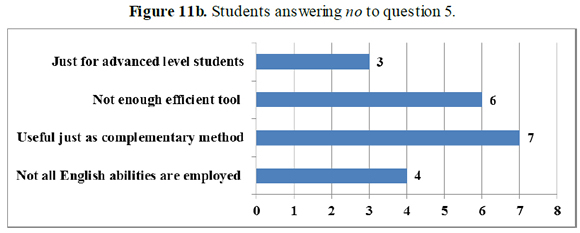
Those students who had an affirmative answer showed two main tendencies: the most common was the fact that they consider translation an all round learning method because of the opportunity that this subject offers to the student to practice different aspects of the target language. Then, other students believed that translation could work as an excellent method to teach a foreign language.
Those students who gave a negative answer thought that translation is not complete enough to be used as a teaching method. However, they did not show a radical position, since most of them think that translation is an excellent complementary tool in order to progress in their English classes. Others think that translation is not an efficient tool, as not all language skills are employed or it is efficient just for advanced level students.
Question 6
Do you use, or would you use translation to improve your English skills?
The next graphic shows the incidence of yes/no answers:
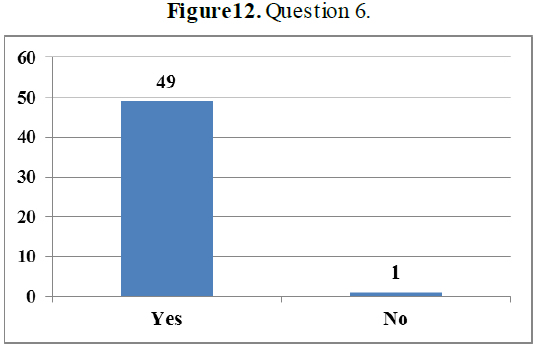
There is a clear tendency for this question, as almost all the students gave an affirmative answer. Only one student thinks that translation is not useful to improve his/her English skills. The next graphic shows the main opinions of those students who think that translation is useful to improve their English skills:
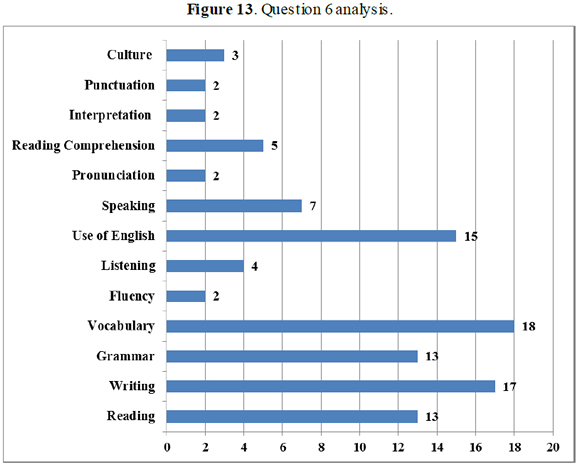
The language skills that were mentioned by the students more times were vocabulary acquisition, writing, and use of English, reading, grammar and speaking. They consider that these abilities are improved when using translation. Other students mentioned skills such as reading comprehension, listening, culture knowledge, punctuation, interpretation, pronunciation and fluency.
Question 7
In your translation classes, do you feel that all language skills are developed?
In the next graphic we present the number of yes/no answers:
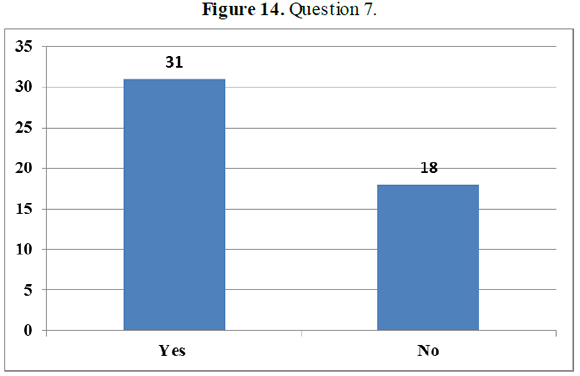
There is a greater number of affirmative answers (those students who think that translation involves the four language skills). On the other hand, those people who gave a negative answer think that just some skills are employed in translation.
Most of the students who think that translation involves the four skills consider that writing and reading are more employed, and they added that speaking and listening are practiced in a more balanced way during an interpretation course, since it is based on oral translation.
The next graphic shows the incidence of those skills that are considered by the students as being developed through translation:
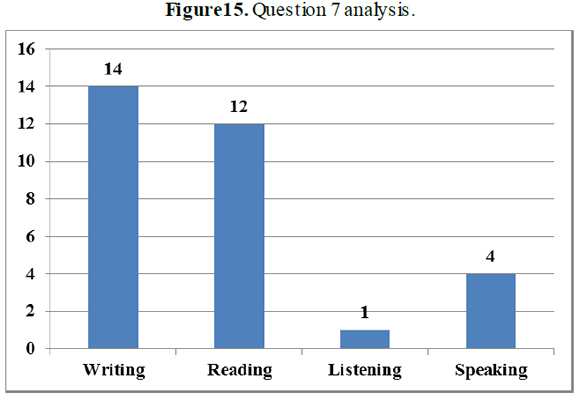
It is obvious that there is a greater trend for the writing and reading skills. On the other hand, there is a lower incidence of the listening and speaking skills.
Discussion
It was found that almost all the students who participated in the surveys agreed that translation has helped them to improve their English language learning. They think translation is an important subject to make a constant progress in their English proficiency. One aspect that was relevant in our research is the fact they were really clear when specifying the skills they consider improved after facing translation as a subject.
We noticed that most students believe that their vocabulary has increased since they started working with translation. It is important to mention this point since translation has been taken into account as a useful activity to learn new words.
It was found that the translation class is considered as an important pedagogical tool as regards the use of English skill, in line with Cook’s (2001) opinion.
The students had a certain amount of knowledge about techniques and methods in the foreign language learning and teaching processes due to the fact that some subjects included in the English Language Major curriculum cover these knowledge areas. It means that they are able to identify what a pedagogical tool is and how a teaching method works.
The results in the surveys not only reinforce the hypothesis that we formulated before, but also reinforce the information that supports this thesis. The scholars who designed teaching methods including translation as pedagogical tool and those who support these methods attached great importance to translation because of its role in class. In this research it was found that students overwhelmingly support this stance.
Translation can be useful to practice different linguistic skills; however, it is not a completely balanced activity. The students perceive this unbalance; they consider that there is a clear tendency to work much more with the reading and writing skills.
It was found that there was a big tendency in the development of the writing and reading skills. Furthermore, they mentioned some abilities that are closely related with those skills such as: reading comprehension, punctuation and especially vocabulary, supporting at least one of Ross’s (2000) suggestions.
The new strategies which include translation as a pedagogical tool have changed in order to adapt the teaching strategies that were part of the grammar translation method. The new translation methodologies are focused on more dynamic activities in order to avoid tedious or extremely structured classes. Now the students have the opportunity to use and take advantages of better material. They reflected in the questionnaires their enthusiasm for using varied material. Also, they consider crucial for their progress the interaction that they have with the teacher to discuss the use of words in different contexts.
It is important to state that according to the results and comparison with the literature review, the most significant result that may draw the attention is that the teachers of translation at the University of Quintana Roo avoid most of the disadvantages that may occur in a class when translation is used as a teaching resource, because teachers don’t focus only on the final product but also on the processes developed while translating.
There are different coincidences between the advantages of translation that are stated in the literature review of this research and the advantages that the students relate to translation, according to the results of the survey.
Further research on this topic is needed, in order to evaluate the impact of the use of translation in foreign language acquisition through quantitative data. The outlawing of written and oral translation in mostly monolingual students’ classes is linked to the so-called foreign-cultural approach, which focuses exclusively on the target language and culture. This approach is being severely questioned today, as the need for creating intercultural approaches in foreign language pedagogy is deeply felt throughout the world, as a means to foster international understanding and to promote peaceful coexistence through communication among people from different countries.
Notes
* Profesor investigador. Coordinador Servicios de Traducción e Interpretación Universidad de Quintana Roo. Correo electrónico: azanier@uqroo.mx
References
Bassnett, Susan (1998) Translation Studies. London, New York: Routledge.
Bowen, Tim & Marks, Jonathan. (1994) Inside Teaching. Oxford: Oxford University Press.
Carreres, Angeles. (2006). Strange bedfellows: Translation and Language Teaching. The teaching of translation into L2 in modern languages degrees: uses and limitations”. Retrieved on (21-11-09). From: http://www.cttic.org/ACTI/2006/papers/Carreres.pdf
Cunningham, Cindy. (2000). “Translation in the Classroom. A Useful Tool for Second Language Acquisition”. Retrieved on (21-3-10). From: http://www.birmingham.ac.uk/Documents/college-artslaw/cels/essays/secondlanguage/cindyc2.pdf
Durieux, Christine. (2005). L’enseignement de la traduction: enjeux et demarches. Translators’ Journal, 50 (1), 36-47. Accessed on line 19-VIII-2013. Available at http://id.erudit.org/iderudit/010655ar
Edge, Julian. (1993). Essentials of English Language Teaching. New York: Longman.
Finocchiaro, M. & Brumfit, C. (1983) The Functional-Notional Approach. Oxford, England: Oxford University Press.
González- Davies, María (2004) Multiple Voices in the Translation Classroom. Amsterdam: John Benjamins.
Harmer, Jeremy. (1990). The practice of English Language Learning. New York: Longman.
Harvey, S., Higgins, I. & Haywood, L. (1994) Thinking Spanish Translation. London: Routledge.
Howatt, A.P.R. (1984) A History of English Language Teaching. Oxford, England: Oxford University Press.
Kavaliauskien, Galina & Janulevien, Violeta (2002) Promoting the Fifth Skill in Teaching ESP. In “English for Specific Purposes World” –Web-based Journal. Accessed on line 20-VII-2013. Available at www.esp-world.info/Articles.ESP.html
Lunn, Patricia Vining and Lunsford, Ernest Jackson (2003) En otras palabras. Washington: Georgetown University Press.
Nunan, David & Lamb, Clarice (1996) The Self-Directed Teacher. Cambridge, U.K: Cambridge University Press.
Paradowsky, Michael B. (2007) Exploring the L1/L2 Interface. A Study of Polish Advanced EFL Learners. Warsaw: Warsaw University, Institute of English Studies.
Yule, George. (1996). The Study of Language. Cambridge, England: Cambridge University Press.